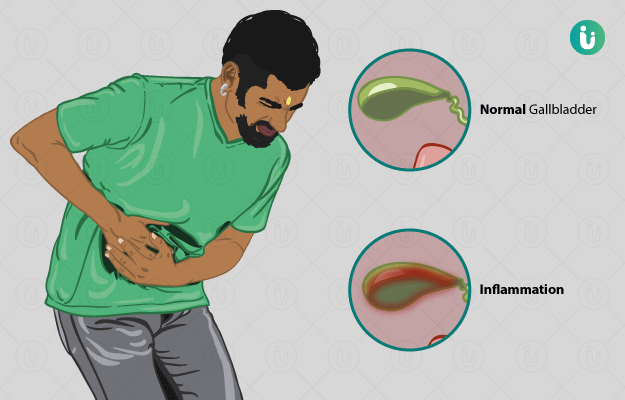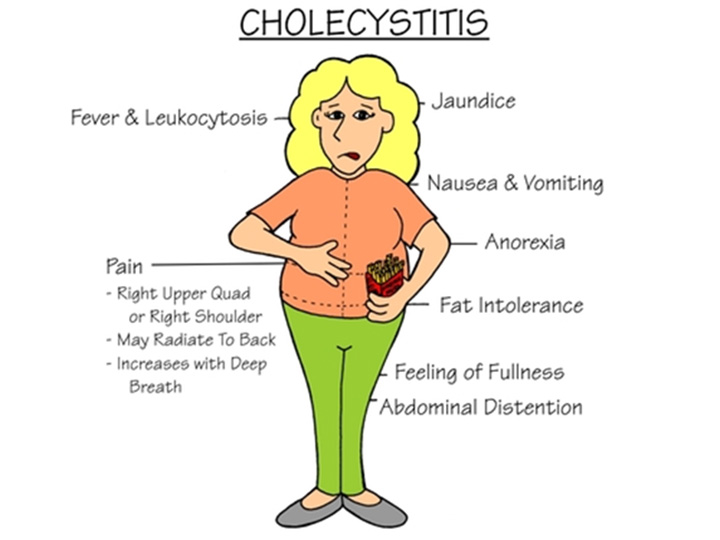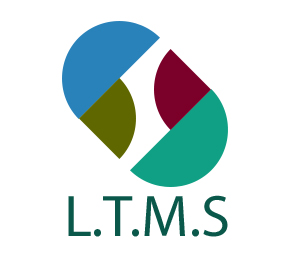WHAT IS CHOLECYSTITIS?
Cholecystitis is an inflammation of the gallbladder. The gallbladder becomes distended, and severe complications can arise. It can happen when a gallstone gets stuck at the opening of the gallbladder.

Symptoms can include fever, pain, and nausea. Without treatment, cholecystitis can result in perforation of the gallbladder, tissue death, gangrene, secondary bacterial infections, and fibrosis and shrinking of the gallbladder. Treatment for cholecystitis often involves surgery to remove the gallbladder.
WHAT ARE THE CAUSES OF CHOLECYSTITIS?
The main cause of cholecystitis is gallstones or biliary sludge becoming trapped at the gallbladder’s opening. Doctors may sometimes refer to this as a pseudolith, meaning a “fake stone.”
Other possible causes include:
- injury to the abdomen from burns, sepsis, trauma, or surgery
- shock
- immune deficiency
- prolonged fasting
- vasculitis
WHAT ARE THE SYMPTOMS OF CHOLECYSTITIS?

Symptoms of cholecystitis may include:
- Severe pain in your upper right or center abdomen
- Pain that spreads to your right shoulder or back
- Tenderness over your abdomen when it’s touched
- Nausea
- Vomiting
- Fever
Cholecystitis symptoms often occur after a meal, particularly a large or fatty one.
WHO IS AT RISK OF HAVING CHOLECYSTITIS?
You are at greater risk of developing cholecystitis if you:
- Have a family history of gallstones.
- Are a woman age 50 or older.
- Are a man or woman age 60 or older.
- Eat a diet high in fat and cholesterol.
- Have overweight/obesity.
- Have diabetes.
- Are of Native American, Scandinavian or Hispanic descent.
- Are currently pregnant or have had several pregnancies.
- Takes estrogen replacement therapy or birth control pills.
- Have lost weight rapidly.
WHAT ARE THE COMPLICATIONS OF CHOLECYSTITS?
Untreated chronic or acute cholecystitis can lead to:
- Fistula: This occurs when a large stone erodes the wall of the gallbladder. This can link the gallbladder and the duodenum, resulting in a leak of stomach acid.
- Gallbladder distention: If the gallbladder becomes inflamed because of bile accumulation, it may stretch and swell, causing pain. There is then a much higher risk of perforation, or tearing, in the gallbladder, as well as infection and tissue death.
- Infection of the gallbladder: Bacteria that proliferate in the gallbladder can cause this rare and life threatening complication, which is known as emphysematous cholecystitis. People who also have diabetes are more at risk.
- Cholestasis: This is a rare complication in which the bile duct becomes blocked, and bile is unable to flow.
- Pancreatitis: Pancreatitis occurs when gallstones pass from the gallbladder into the biliary tract, leading to an obstruction of the pancreatic duct.
Additional complications that can occur include an abscess in the abdomen, bleeding, liver damage, bowel damage, and gallstones that remain in the bile duct.
WHAT ARE THE DIAGNOSIS IN OUR FACILITY?
We will usually ask whether a person has a history of cholecystitis because it often re-occurs. We will also determine how tender the gallbladder is by performing a physical examination.
In some cases, we may order the following tests:
- Complete blood count: A high white blood cell count may indicate an infection. High levels of bilirubin, alkaline phosphatase, and serum aminotransferase may also help the doctor make a diagnosis. However, these markers may not be present in the chronic version.
- CT scans or ultrasound: Images of the gallbladder may reveal signs of cholecystitis.
- Hepatobiliary iminodiacetic acid (HIDA) scan: Also known as cholescintigraphy, hepatobiliary scintigraphy, or hepatobiliary scan, this scan creates pictures of the liver, gallbladder, biliary tract, and small intestine.
The information from these tests allows the doctor to track the production and flow of bile from the liver to the small intestine. In doing so, they can determine whether there is a blockage and, if so, confirm its location.
WHAT ARE THE TREATMENT OPTIONS?
Treatment of cholecystitis usually takes place in the hospital. Treatments may include:
- Fasting, to rest the gallbladder.
- IV fluids to prevent dehydration.
- Pain medication.
- Antibiotics to treat infection.
- Removing the gallbladder. This surgery, called a cholescystectomy, is usually performed by making tiny cuts (incisions) through the abdomen to insert a laparoscope (tiny camera) to see inside the abdomen and surgical instruments to remove the gallbladder. The gallbladder is usually removed within 24 to 48 hours of admission if you have a confirmed case of acute cholecystitis.
- Draining the gallbladder to treat and prevent the spread of infection. This procedure, called percutaneous cholecystostomy, is usually reserved for those who are too ill to undergo surgery.
- Removing gallstones in the area blocking the common bile duct. This procedure, done by an endoscopist, called endoscopic retrograde cholangiopancreatography (ERCP), is reserved for patients with a suspected or confirmed blocked common bile duct, and can clear the duct of stones and sludge.
DIET
After recovering from the condition, it is important to make dietary adjustments that help return bile production to normal.
A person should eat smaller meals more frequently and avoid large servings or portions, as these can upset the system and produce a gallbladder or bile duct spasm.
A person should also avoid high fat and fried foods, including whole milk products, and stick to eating lean proteins.
HOW CAN CHOLECYSTITIS BE PREVENTED?
Some measures can reduce the risk of developing gallstones, which can decrease the likelihood of cholecystitis. These measures include:
- Avoiding saturated and trans fats
- Keeping to regular breakfast, lunch, and dinner times and not skipping meals
- Getting regular physical exercise
- Losing excess body weight, as obesity increases the risk of gallstones
- Avoiding rapid weight loss, as this increases the risk of developing gallstones.
WHAT ARE THE OUTLOOKS?
With appropriate treatment, which is usually a cholecystectomy, most people with cholecystitis will recover and have a good outlook. However, in rare cases, surgical complications can occur.
If gallstones are not responsible for the condition, people will usually have another injury or disease that could be life threatening. In such cases, prompt treatment and on-going monitoring in a hospital setting are even more crucial.
FOR FURTHER ENQUIRIES & MANAGEMENT KINDLY REACH US CIA OUR CONTACT PAGE.

Recent Comments